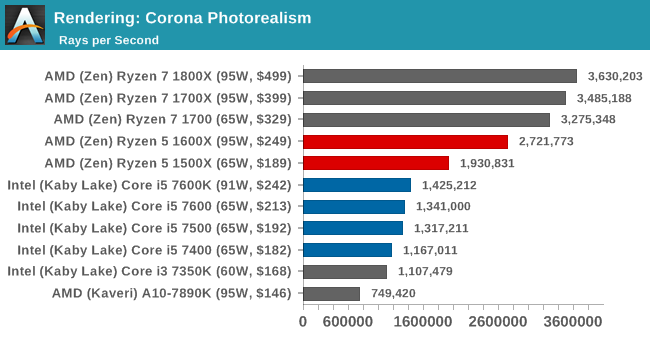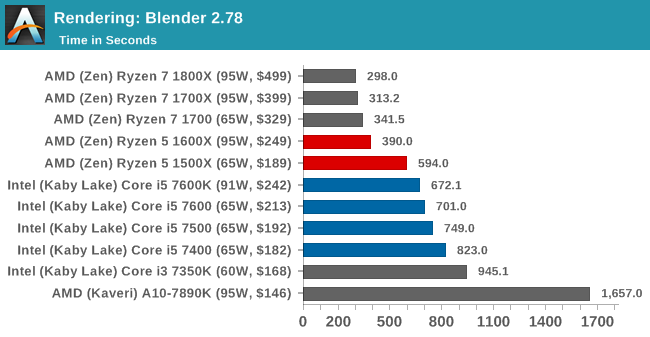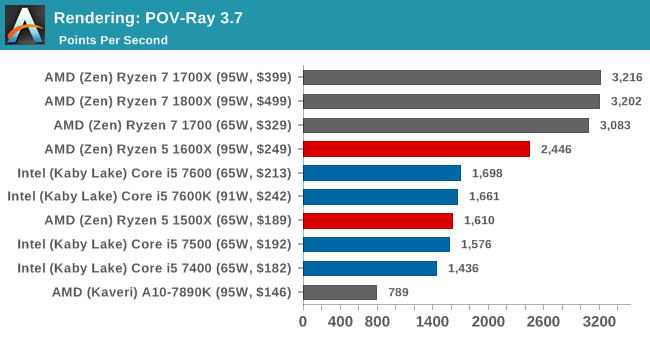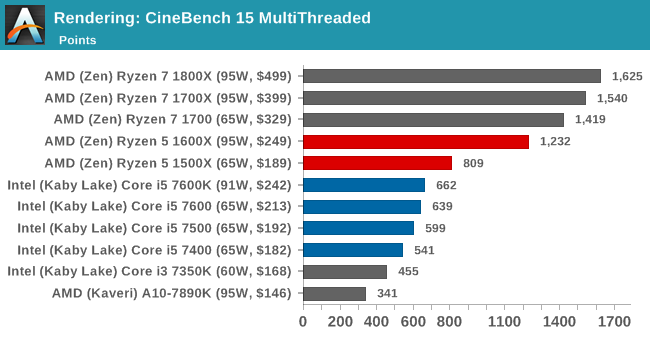The AMD Ryzen 5 1600X vs Core i5 Review: Twelve Threads vs Four at $250
by Ian Cutress on April 11, 2017 9:00 AM ESTBenchmarking Performance: CPU Rendering Tests
Rendering tests are a long-time favorite of reviewers and benchmarkers, as the code used by rendering packages is usually highly optimized to squeeze every little bit of performance out. Sometimes rendering programs end up being heavily memory dependent as well - when you have that many threads flying about with a ton of data, having low latency memory can be key to everything. Here we take a few of the usual rendering packages under Windows 10, as well as a few new interesting benchmarks.
Corona 1.3
Corona is a standalone package designed to assist software like 3ds Max and Maya with photorealism via ray tracing. It's simple - shoot rays, get pixels. OK, it's more complicated than that, but the benchmark renders a fixed scene six times and offers results in terms of time and rays per second. The official benchmark tables list user submitted results in terms of time, however I feel rays per second is a better metric (in general, scores where higher is better seem to be easier to explain anyway). Corona likes to pile on the threads, so the results end up being very staggered based on thread count.
Blender 2.78
For a render that has been around for what seems like ages, Blender is still a highly popular tool. We managed to wrap up a standard workload into the February 5 nightly build of Blender and measure the time it takes to render the first frame of the scene. Being one of the bigger open source tools out there, it means both AMD and Intel work actively to help improve the codebase, for better or for worse on their own/each other's microarchitecture.
POV-Ray 3.7.1
Another regular benchmark in most suites, POV-Ray is another ray-tracer but has been around for many years. It just so happens that during the run up to AMD's Ryzen launch, the code base started to get active again with developers making changes to the code and pushing out updates. Our version and benchmarking started just before that was happening, but given time we will see where the POV-Ray code ends up and adjust in due course.
Cinebench R15
The latest version of CineBench has also become one of those 'used everywhere' benchmarks, particularly as an indicator of single thread performance. High IPC and high frequency gives performance in ST, whereas having good scaling and many cores is where the MT test wins out.















254 Comments
View All Comments
Dr. Swag - Tuesday, April 11, 2017 - link
Is it just me that sees "[table]" in the test bed and setup part? :PIan Cutress - Tuesday, April 11, 2017 - link
As always, still writing as the embargo passes :D Always down to the wire, then over the wire, and a hop skip and a jump into a fast typing frenzy of fastidious fire.Dr. Swag - Tuesday, April 11, 2017 - link
No worries :). I can only imagine how much testing you've been doing ever since the Ryzen 7 launch :DYou guys are still my favorite review site. Keep up the good work!
AndrewJacksonZA - Tuesday, April 11, 2017 - link
Thanks Doc! I pretty much always prefer your in-depth analysis to other authors on other review sites. I really enjoy the way you do and word things - I put it down to a combination of your academic and pro-OC background. :-)Cheers,
Andrew
ianmills - Tuesday, April 11, 2017 - link
Ian it would be great if there was some easy way to only see only the parts of the review that are updated. Perhaps a diff can be done somehow ;)EasyListening - Tuesday, April 11, 2017 - link
Hey you rhymed!leexgx - Thursday, April 13, 2017 - link
EEC compatibility (not support at the moment) you can use ECC ram but the ECC functionality is disabled (don't know when or if AMD will enable it on none workstation CPUs)MajGenRelativity - Tuesday, April 11, 2017 - link
You mention a Ryzen 1400X in the conclusion, but I only see a 1500X and a 1400 at the beginning of the review. I do see a 1500X in the chart, so maybe you mean that?Paragraph just before "On the Benchmark Results"
Ian Cutress - Tuesday, April 11, 2017 - link
I did indeed. :) Updated.MajGenRelativity - Tuesday, April 11, 2017 - link
I figured as much, unless you had access to a secret CPU I'd never seen before :P